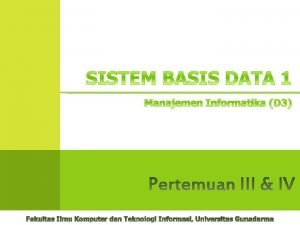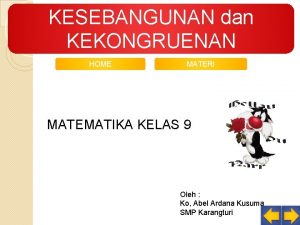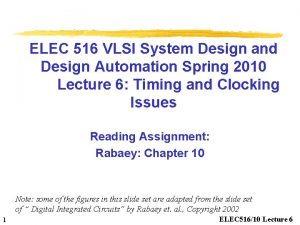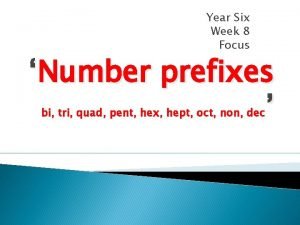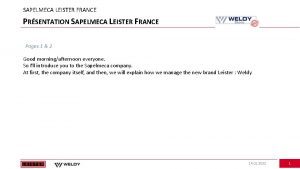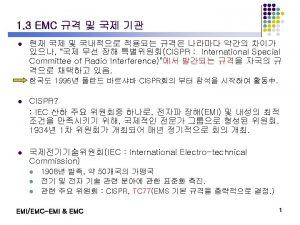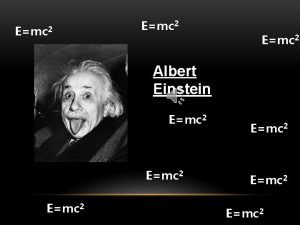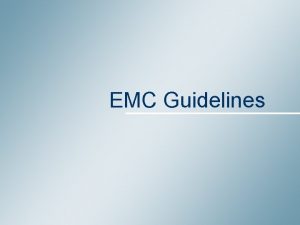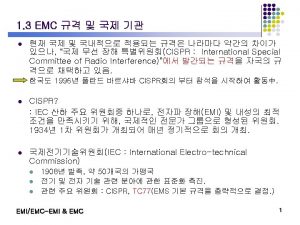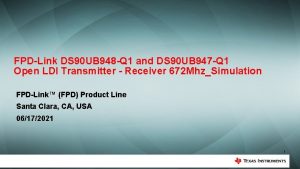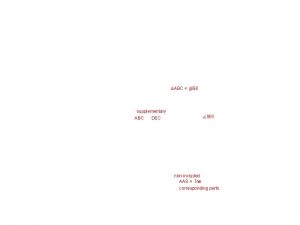EMC for FPDLink IIIIV Mike Leister Dec 14









- Slides: 9

EMC for FPD-Link III/IV Mike Leister Dec 14, 2018 1 TI Confidential – NDA Restriction

Radiated Emissions • CISPR 25 L 5: TI test focus • RE-310 (Ford) • IEC-60001 • ISO-11452 -2 • 3800808 (Renault) • Others TI Confidential – NDA Restriction 2

EVM Radiated Emissions Debug • Test Preparation – – • Board design & modifications – – – • Avoid length mismatch and impedance discontinuities on PCB signals. Fix length matching prior to long straight runs. Disable the EVM 12 V to 5 V buck regulator and replace with off-board LDO with a large heat sink. • Upcoming EVMs have EMC-friendly buck regulators • If a switching regulator must be used, select an EMC-optimized one and add a snubber to the switch node Terminate differential deserializer outputs with 100 ohms (for EVM testing; customer systems should be terminated at the sink) Cable and DC power connectors located next to each other has been observed to provide better emissions performance. Anti-pad under inductors and larger capacitors to reduce coupling Low inductance connection from board ground to shield box At the test facility – – • Pre-test with near field probes before going to the test chamber. Details on the next slide. Use a new cable. Many major manufacturers discard FAKRA/STQ cables after 20 insertions. Tape the cable down, lower cables radiate less. Smaller shield boxes perform better. Use the smallest possible. Make entry holes as small and low as possible. Have the power and link cable enter together. Copper wool seals small holes 2 d. B better than copper tape in a recent experiment (don’t have large holes). If testing with a TI EVM, shut down USB 2 ANY after programming registers. Always run an ambient sweep. I once had a De. Walt battery powered drill hidden in a cardboard box cause a failure at 50 MHz. Make sure the 12 V battery is charged. Measure it yourself. Make the final power connection yourself. Mitigation & Debug steps – – – Small value resistor in series with REFCLK slows the edge and reduces coupling and radiation. Temporarily turn off back channel to see if that is a major contributor Spread-spectrum clocks for deserializer REFCLK knock peaks down 6 d. B to 9 d. B 3 TI Confidential – NDA Restriction

• EMC Chamber testing shows 6 d. B to 9 d. B improvement in most cases. For signals that do not respond to SSC, check an ambient sweep to ensure external emitters are not present. EMC Chamber Standard REFCLK • Link margin testing shows that up to 0. 5% spreading SSC can be supported Full CISPR 25 GPS Zoom-in DS 90 UB 953/954 Standard REFCLK Near-Field Probe Standard REFCLK Optimize Emissions Before Chamber Testing 4 TI Confidential – NDA Restriction

Radiated Immunity • ISO-11452 -4 (BCI): TI test focus • RI-113/114/115 Radiated, reverb chamber (Ford) BCI Inject 200 m. A Sweep from 1 MHz to 400 MHz Repeat for CW and AM signals Monitor lock change count Repeat for various distances from the SER. 5 TI Confidential – NDA Restriction

Radiated Immunity Debug • Optimize AEQ/s. FILTER – • Use the ALP Margin Analysis tool to determine acceptable AEQ settings. Set AEQ/s. FILTER min/max limits to allow only setting near the center of the “eye”. Use the AEQ settings to increase the LOCK tolerance to errors (95 x example). – – – Allow lock to establish with default AEQ settings After Lock, Set 0 x. B 9 to 0 x 3 F. This increases the number of errors required for LOCK to drop. If this does not work, try the next three steps, one at a time. Set 0 x 42(4) to 0 x 0. This stops parity errors from causing LOCK drop and is in line with how later parts operate. Set 0 x 42(5) to 0 x 0. This stops packet encoding errors from causing LOCK drop. Set 0 x 42(6) to 0 x 0. This stops FPD-Link Clock errors from causing LOCK drop. • We have seen immunity failures caused by power supply current limits. Check the voltage rails to make sure they stay in spec during the test. An optical probe is useful for this. • Try a common mode choke on the serial path if using STP/STQ. We use DLW 21 SZ 900 HQ 2 L. • Try adding a 10 u. F to 22 u. F ceramic cap from DC power to ground right at the DC connector. • Try a 2 p. F ceramic cap across the differential serial path near the AC blocking caps. If this works, check link margin to be sure it will work in the customers design. • Try a ferrite bead between cable shield and board ground. We have an experiment planned to quantify the effect. • Most of the time, you can get better BCI results without the EMC shield boxes. • Use EMC absorption sheets to narrow down where the vulnerable area is. • Use shielded connectors. TI Confidential – NDA Restriction 6

System Level ESD Testing & Debug • Most debug advice for radiated immunity can be applied to ESD testing • TVS across RIN/ROUT has been helpful • In IVI cases you can use the system SW to freeze the image when lock drops and resume after lock is reestablished. ESD is a quick event, and many customers are satisfied with masking the dropped lock so their customer does notice. • Don’t try holding the ESD gun, you will likely get inconsistent results. Use an articulated arm and fire it remotely. • Many customers pre-test ESD and immunity with a piezo BBQ igniter. Click it at various locations around the system and monitor for dropped lock. • Run System Level ESD tests with – – Use connectors that offer 360 degree transition from Shield to Board Ground so the Ground transition is smooth and continuous. Well-balanced STP cable; Identical metal enclosures, Use CM chokes on the board to mitigate any cable Imbalance • Good connection between shield and the Chassis at the connector. Ensure that all supplies within the board are well-coupled to the system ground so supply and ground track transient injected signals well • Snap ferrites around the cable shield at the connector (where cable connects into the system) 7 TI Confidential – NDA Restriction

FGTDS Board EMC Improvements We engaged with the Ford FGTDS program using EMI-optimized EVMs. • Place 30 mil poly keep-outs around the FPD high speed traces around the RF connector pins. • Place continuous GND pours between digital signals with large gaps between them. • Make sure that any AC coupling caps, chokes are used on the high speed traces are not placed adjacent/parallel to each other. • Follow connector vendor recommended footprint. Maintain 3 trace widths spacing for signals routed around the RF connectors. • Add “symmetrical” GND vias near the vias. A ground via should be added as close as possible to where the differential signal lines change layers. These ‘matching ground’ vias should be placed equal distance above and below the transition vias. • Ensure that high-speed signals enter coupling devices at 90 degree angles. • It is recommended to remove GND area underneath the inductor at switcher on all layers to minimize the emission and coupling effect. 8 TI Confidential – NDA Restriction

GPS Zoom-in DS 90 UB 953/954 Standard REFCLK Near-Field Probe 0. 5% SSC REFCLK • EMC Chamber testing shows 6 d. B to 9 d. B improvement in most cases. For signals that do not respond to SSC, check an ambient sweep to ensure external emitters are not present. EMC Chamber Standard REFCLK • Link margin testing shows that up to 0. 5% spreading SSC can be supported Full CISPR 25 Near-Field Probe Standard REFCLK Advantages of Deserializer SSC REFCLK 9 TI Confidential – NDA Restriction
